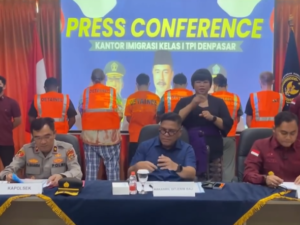
The ambitious Bali Urban Subway, a transit project that promises to reshape the landscape of Dewata’s tourism and traffic woes, is one step closer to reality following a high-profile pitch to Indonesia’s Coordinating Minister of Infrastructure and Regional Development, Agus Harimurti Yudhoyono (AHY).
Acting Bali Governor Sang Made Mahendra Jaya took center stage at a strategic meeting in Bali’s Ngurah Rai Airport, unveiling an infrastructure vision aimed squarely at curbing the notorious traffic snarls that have increasingly impacted the island’s tourism economy.
In the meeting with AHY and key figures from Bali’s regional planning and infrastructure departments, Governor Mahendra Jaya spotlighted the subway as a “vital solution” for Dewata.
“The routes are tailored to the island’s busiest traffic corridors. If we can extend the subway all the way to Tanah Lot, it would be a major win for our tourism sector,” he asserted.
This public plea for central government support marks a shift in the subway’s development trajectory, as previously the project had been pegged to receive 100% of its funding from private investors.
A New Financial Blueprint Takes Shape
Earlier this year, Bali’s government began courting private investors for the subway, determined to build an entirely privately-funded urban transport system to avoid burdening Bali’s regional budget (APBD) or the national budget (APBN).
Spearheaded by PT Sarana Bali Dwipa Jaya (SBDJ), a regional development company, the project attracted its first private backer in July: PT Bumi Indah Prima (BIP). This partnership underscored the high-risk appetite among stakeholders, especially as BIP committed without any financial guarantees from the government.
The investment framework centers on a long-term public-private concession, with SBDJ aiming for a 50-year operational handover, after which the subway would revert to full regional control.
The partnership has come with a hefty price tag, with the initial phase alone projected at a $10.8 billion USD investment (followed by an additional $9.2 billion USD for the later development phases, amounting to approximately 314 trillion IDR in total).
To tackle the logistics, PT SBDJ brought in construction heavyweight China Railway Construction Corporation (CRCC) alongside local contractor PT Sinar Bali Bina Karya. The first tunnel boring machines are slated for arrival in April 2025, signaling the project’s shift from blueprint to groundbreaking.
However, the shift towards government funding emerged as the project’s complexity—and costs—grew.
The decision to seek APBN support highlights Bali’s desire to solidify this project as a flagship example of sustainable tourism infrastructure, critical not only for daily commuters but also for the millions of tourists who visit annually.
Indonesia’s National Development Planning Agency (Bappenas) has emphasized that this project is an integral part of Bali’s “Kerthi Bali Economic Roadmap,” a comprehensive development plan unveiled in 2021. The roadmap envisions a future where Bali is not only a tourism hotspot but a model of sustainable and resilient economic growth.
Balinese Philosophy and Modern Tech: A Symbiotic Approach

In crafting the subway’s layout, SBDJ’s design teams were mindful of Bali’s cultural heritage. Rather than constructing above ground, which would require significant land acquisitions and disrupt landscapes, the project champions an underground model. This approach aligns with the Balinese principle of Tri Hita Karana, emphasizing harmony between humanity, nature, and the divine, according to Antara News.
The four-phase construction plan will initially connect Bali’s Ngurah Rai Airport to Seminyak, Kuta, and further northward, with subsequent phases planned for Jimbaran, Nusa Dua, Ubud, and more. Each phase is set to blend transport utility with minimal environmental disruption, aligning with Bali’s commitment to sustainable development.
Next Steps: Awaiting Governmental Support
Governor Mahendra Jaya’s appeal to Minister Yudhoyono underscored the pressing need for national fiscal and regulatory backing.
While the project currently stands as a beacon of private-public innovation, logistical and regulatory challenges persist. These include legal provisions for subterranean construction and route approvals. With AHY’s attention, Bali’s officials hope to streamline these hurdles and possibly secure additional central government resources.
Should all go according to plan, the Bali Urban Subway is projected to launch its initial phase by 2028, ushering in a new era of seamless transit for both tourists and residents.
The subway’s comprehensive plan is not only geared toward transport efficiency but also toward transforming the tourist experience by making Bali more accessible and less congested year-round.
Public Response and Future Implications
As anticipation builds, many locals hope that this project will bring relief from the seasonal traffic jams that coincide with peak tourist arrivals.
For Bali’s residents, discussions are underway on special fare reductions, with the possibility of a complimentary service for locals. As for tourists, who will make up the bulk of the subway’s ridership, the anticipated fare structure would run at around $35–$40 per week, providing all-inclusive transit access across Bali.










